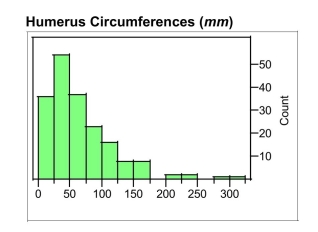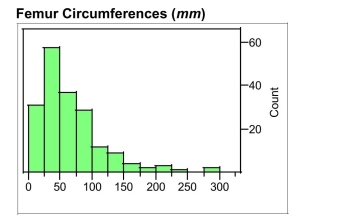The average circumferences (distances around) in mm of the humerus, femur, and tibiaof different species of mammals are displayed below. These long bones primarilysupport the body mass in mammals. Each data value is the mean circumference forthe available measures for a single species.the distributions of these different bones.(a) Describe the differences and similarities in  (b) Biologists speculate that greater weights
(b) Biologists speculate that greater weights  might be supported by larger bones. Based onthe histograms, if the biologists' speculationsare correct, which of these bones (humerus,femur, or tibia) would seem to be the leastable to support a large weight?
might be supported by larger bones. Based onthe histograms, if the biologists' speculationsare correct, which of these bones (humerus,femur, or tibia) would seem to be the leastable to support a large weight?
Explain,referring to specific aspects of the histograms. 
Definitions:
Q7: <img src="https://d2lvgg3v3hfg70.cloudfront.net/TB5309/.jpg" alt=" " class="answers-bank-image d-block" rel="preload"
Q11: The P-value is used to calculate the
Q13: In general, a wider confidence interval is
Q15: The ZZZ chain of motels has a
Q15: A cell has at least 3 and
Q15: For paired samples <img src="https://d2lvgg3v3hfg70.cloudfront.net/TB5309/.jpg" alt="For paired
Q26: First graders at an elementary school were
Q76: A yardstick measures <span class="ql-formula"
Q89: One gallon of a driveway sealant covers
Q181: 70%<br>A) 0.07<br>B) 0.7<br>C) 0.59<br>D) 7